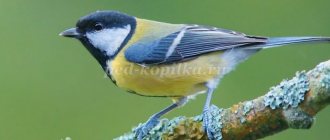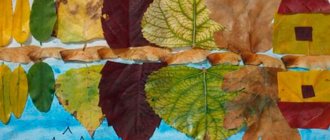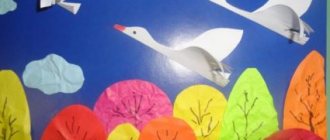Application "Swan"
author: Mavlyutova Ramilya Rayanovna
Educator Municipal state-owned preschool educational institution kindergarten "Beryozka"
Application "Swan"
Program content:
Educational objectives:
consolidate knowledge about the swan as a migratory bird; improve skills in working with scissors (cut in a straight line); create the image of a swan using loops of paper, and lay them in rows, using your existing skills in working with paper.
Developmental tasks:
develop speech, memory, attention, imagination.
Educational tasks:
cultivate a caring attitude towards birds; the ability to work together, amicably and consistently.
Corrective tasks:
develop fine motor skills of fingers
Priority educational area:
artistic and aesthetic development (application)
Integration of educational areas:
social - communicative.
Subject-spatial development environment of the NNOD theme:
group room, scissors, white paper, cardboard.
Introductory part (motivational, preparatory stage)
| Educational objectives | Contents of NNOD | Educational field, type of activity | Forms of Program implementation | OOP Implementation Tools | Planned result |
| Mystery: Proud bird Not afraid of water Very pretty Looks like a deuce What's your name, answer me! It is white … The teacher offers to play the game “Tender Word”, but the word should be about swans. (For example: good swan, beautiful swan, etc.) | social – communicative, communicative | Special modeling of communication situations | The teacher's word, the children's speech. Toy hare. | The motivation of children for upcoming activities, communication, and interaction between the child and the adult has been formed. |
Main part (content, activity stage)
| Educational objectives | Contents of NNOD | Educational field, type of activity | Forms of Program implementation | OOP Implementation Tools | Planned results |
| Development of communication, interaction between a child and an adult. Formation of elementary ideas about types of art. Implementation of independent creative activity of children. Development of fine motor skills of the hands. Development of movement coordination. | Finger gymnastics. Children show how swans shake their heads (flexion and extension of the index finger, alternately on each hand, the remaining fingers clenched into a fist). Swans fly (voluntary finger movements). On a finished background (2 cardboards are fastened together with tape, the children, with the help of the teacher, glue the swan. Next, the teacher gives each child 1/2 of a landscape sheet and asks them to cut along the lines along the drawn strips. The children glue the cut lines (glue is smeared on the edge of one strip , after which the strip is bent and glued with the edges to form an oval. The children, with the help of the teacher, glue the resulting rings onto the swan, thereby forming a three-dimensional wing. After which each child is given a part of the reed (a stem, 2 leaves and the reed itself). | Artistic and aesthetic; design; Social-communicative; communicative; Physical; motor. | Special modeling of communication situations. Outdoor game. Finger game. | The teacher's word, the children's speech. Plasticine, stacks, modeling boards. | Communication and interaction between a child and an adult have been formed. They have a basic understanding of the types of art. Independent creative activity of children has been formed. Fine motor skills and coordination of movements have been developed. |
Final part (reflective stage)
| Educational objectives | Contents of NNOD | Educational field, type of activity | Forms of Program implementation | OOP Implementation Tools | Planned results |
| Development of communication and interaction of the child with adults and peers. Self-regulation of one's own actions. | The teacher sums up the lesson and conducts reflection. Evaluation criteria: Raise your right hand if the work is done neatly and beautifully. Raise your left hand if there are any irregularities in the work. | Social and communicative; communicative | Special modeling of communication situations. | Teacher's word, children's speech | Communication and interaction between a child and an adult have been formed; self-assessment of one's own activities. |
Project at the preschool educational institution “Migratory Birds”
- May 26, 2015
Conference “Project activity in an educational institution - 2015”
Nomination “Pedagogical project in a preschool institution”
Dates: 03/15/2015 – 03/31/2015.
Project type : creative, short-term.
Type of project : family, group.
Number of project participants : teachers, children – 13 people, parents – 8 people.
Children's age : 5-6 years.
Relevance of the project implementation. Currently, issues of human interaction with nature have become an environmental problem. If people do not learn to take care of nature, they will destroy our planet. And in order to prevent this from happening, it is necessary to cultivate an environmental culture and responsibility in children from preschool age, since the knowledge acquired in preschool age is later transformed into strong beliefs. By introducing children to nature, we cultivate an ecological and cultural personality.
Problem and hypothesis. In the process of working with children of senior preschool age, an insufficient level of knowledge about migratory birds and the peculiarities of their life was revealed.
Hypothesis: it can be assumed that in order to increase the level of knowledge and ideas of children about migratory birds, it is necessary to use not only traditional forms of work with children, but also modern approaches (independent search for information by children together with their parents, exchange of information in a group between children
Project goal : To form children's ideas about migratory birds and their habitat.
Project objectives:
- Educational: Expand children’s knowledge and ideas about migratory birds and the features of their life. Create a developmental environment for the formation of ideas about the surrounding reality and the development of coherent speech through the use of ICT tools, selection of educational encyclopedic literature, and creation of posters.
- Developmental: Develop cognitive activity, the desire to learn new things, and share your knowledge with other students.
- Educational: To cultivate a caring attitude towards living nature.
Expected results:
- Expanding children's knowledge about migratory birds and the peculiarities of their life.
- Formation on this basis of a moral and personal attitude towards the surrounding reality, caring attitude towards birds;
- Development of speech competence of preschool children;
- Unlocking the creative potential of the family;
- Expanding the communicative sphere and practical joint experience of the child and parents.
Stage 1: Preparatory.
- Creating a developmental environment in the group;
- Selection of didactic games;
- Selection of children's and scientific literature, presentations, illustrations;
- Selection of recommendations for parents on completing creative homework;
Stage 2: Project implementation. Work with children.
- Looking at illustrations, viewing presentations
- Reading fiction and scientific literature about migratory birds.
- Learning outdoor games based on words (on this topic).
- Learning nursery rhymes and calls about birds.
- Activities: Familiarization with the environment “Our feathered friends”; Speech development “Examining the painting “The Rooks Have Arrived”, “Drafting a descriptive story using a diagram”; Drawing “Swallow” (watercolor), “Birds of Migratory” (colored pencils); Application (modular) “Swan”; Construction (origami technique) “Rook”, “Swan”, “Goose”; Modeling from plasticine “Birds of Migratory”.
- Organization of children's play activities with didactic games on this topic.
- View a presentation about migratory birds.
- Review of scientific literature.
GAMES AND EXERCISES USED WITH CHILDREN BY PSYCHOLOGIST TEACHER
Tasks:
- Learn to lay out silhouettes of birds from various details, geometric shapes according to a model, imagination.
- Name migratory birds.
- Continue to learn how to sketch birds according to the model.
- Develop attention and logical thinking.
- Exercise children in writing a story on a given topic.
Organization of children's play activities. List of games and exercises: “What’s missing?”; “Recognize by the shadow”; “Who didn’t melt”; "Compare the Birds"; “Whose house?”; "4th extra"; "Cut pictures"; “Draw by dots”; “What first, what then”; “Complete what is missing”; “Build according to the model”; “We are inventing migratory birds.”
Conclusions. During the implementation of the project, children developed an interest in searching for new information and a desire to share their acquired knowledge; knowledge and ideas about the characteristics of the life of migratory birds have expanded; vocabulary on this topic has increased; The card index of games and pictures with information about birds has been replenished. During the work, the children developed a desire to create conditions for birds (building birdhouses, feeding birds). Thus, the put forward hypothesis was confirmed in the process of work.
Appendix 1. Project at the preschool educational institution “Migratory Birds”.
Appendix 2. Presentation.
Author: Alchikova Olga Borisovna, teacher of the 1st qualification category; Lavrienko Natalya Anatolyevna, teacher of the 1st qualification category; Ramilya Islamovna Rakhmatullina, speech therapist; Evseeva Elena Sergeevna, educational psychologist, LG MADOU DSKV No. 7 “Filippok”, Langepas, Khanty-Mansi Autonomous Okrug-YUGRA.


